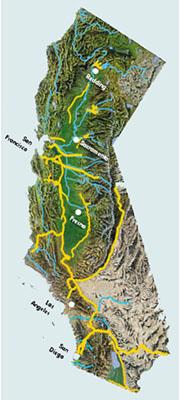Introduction
The Plumbing system and water supply in California is one of the most important commodities and aspects of comfort. Nevertheless, it is used not only for recreation, leisure or comfort, as it is also needed for medical requirements and fire fighting measures. The letter is one of the most demanding aspects associated with water supply, hence, detailed analysis of the piping system is required in order to describe the firefighting measures that are taken in California state.
History of Water Services
Water supply in California may have been started since the foundation of the state, as people always needed water for various needs. The first meters of the piping system were created in the 1920s. The official history of water supply may be counted since 1955 when the California Department of Water Resources was created. The aim of this organization is to monitor and regulate the aspects of water supply and water pollution, as the authority controls the key water reserves that are used for providing the sufficient volumes for the state needs.
Water Sources and Usage
The sources of water supply in California are various, as the state needs up to 12 milliliters of water daily, while the consumption level is cut to 8 megaliters daily during dry seasons. This is explained by the statement that the state is currently experiencing a crisis of fresh water supply. The reasons for this crisis are the eight year drought on the Colorado River and limited local rainfalls during 2008-2009.
In general, the sources of water supply are the Bay-Delta and Wetlands in California, nevertheless the existing difficulties in water supply made the authority come to the decision to cut the usage of fresh water from some of the sources in order to prevent the drying out.
Treatment
In spite of the difficulties and discomfort of water supply cuts, the citizens of California State mainly realize the existing problem; while some sources cut off the municipal water supplies, water consumption authorities are promoting the installation of water saving technologies into the piping system. These are the water counters and optical water dispensers, which restrict the water consumption levels, and help citizens to cut the water supply expenses. In general, the treatment is define by the single environmental protection concept which outlines the key strategy of water consumption and saving.
System Pressurizing
In accordance with the water consumption standards, the pressure required for the urban water supply is 8 bar, while any consumer should get at least 3 bar in the end-point. The California Department of Water Resources decided to cut the pressure as well as the consumption norm. Hence, the urban system maintains the required 8 bar pressure, however, users receive up to 2 bar independently on the geographic location and height.
Type of Piping
The piping that is used for the system presupposes using ecologically safe materials. In accordance with the latest decisions by the California Department of Water Resources, the materials should correspond to the highest standard norms, and provide the required capacity for piping improvement. It is advised that in order the stated water consumption norms reach its standard value, the piping type should be created with the high durability standards in order to prevent leakages and damages.
Type of Hydrants
The classification of hydrants that are used in California is performed in accordance with the pressure and water capacity used in each. The maximal pressure stated for hydrants is 350 kPa. In accordance with the research provided by Michaels (345), hydrant classification is as follows:
Class AA hydrants (>1500gpm) should have their nozzle caps and bonnet colored light blue, Class A hydrants (1000-1499gpm), green, Class B hydrants (500-999gpm), orange, and Class C hydrants (0-499gpm), red. This aids arriving firefighters in determining how much water is available and whether to call for additional resources, or locate another hydrant.
If hydrants are not available, the water is stored in transportable tanks used by firefighting services. It is stated that firefighting services may also use chemical materials for the firefighting measures, however, the strategic water reserve for the emergency services is always kept secured. It is not subjected to everyday consumption, and the emergency water supply system is cared for with high standards. Additionally, the emergency services are using natural water resources if they are available such as rivers and lakes.
Piping Layout
The layout standards depend on the quality standards that are accepted in every municipality. Nevertheless, the general concept of layout creation is closely associated with providing the high quality water supply services for every citizen.
Hydrant Testing
The actual data of hydrant testing depends on numerous parameters such as:
- Hydrant location
- Time and date
- Hydrant inventory number and authority responsible
- Water capacity
- Hydrant classification (Seng, 218)
The map of piping is given in Appendix A. This reveals the actual distribution of the piping network from the key water basins.
Works Cited
Michaels, Sarah. “Configuring Who Does What in Watershed Management: The California Watershed Initiative.” Policy Studies Journal 29.3 (2004): 345.
Seng, James. “California: Social History of Western America.” Journal of American Studies 40.3 (2009): 218
Appendix A
